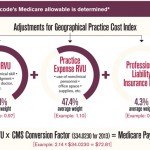How Survey Respondents Are Selected
Based on AMA guidelines, rheumatology members are identified to participate in the AMA surveys through a random sampling of the entire ACR membership. The ACR then emails the RUC survey to the select group of rheumatologists. Members are asked to submit responses by the date provided in the email. Timely responses are critical to allow ACR advisors and staff to review the data before it is submitted to the AMA RUC for consideration.
Completing the RUC Survey
The online survey will take approximately 20–25 minutes to complete. As part of the survey, participants are asked to read a CPT code description and a vignette of the typical patient receiving the procedure. The survey will then ask a series of questions to get your best estimate about the time, intensity and medical decision making involved in performing the procedure. All data will be aggregated to develop final recommendations.
It is critical to read the description of the new or revised procedure code carefully. Participants should not assume the described procedure is necessarily the same as one that is currently being performed or has been performed in the past. Make sure the described procedure is relevant to what is typically performed in the practice. The RUC survey refers to rheumatologists and other non-physician providers as “qualified healthcare professionals.” Note, qualified healthcare professional work includes:
- Time required to perform the service;
- Mental effort and judgment;
- Technical skill and physical effort; and
- Psychological stress that occurs when an adverse outcome has serious consequences.
Step by Step
Participating in a RUC survey has six steps. Here are a few key pointers for each.
- Step 1: Review code descriptor and vignette. The vignette includes a short description of the patient and describes a typical clinical scenario for the procedure.
- Step 2: Review introduction and complete contact information. The survey collects contact and basic practice information, but provider name and information are never forwarded to the AMA or used for tracking purposes.
- Step 3: Identify a reference procedure. The survey includes a list of reference codes for procedures selected as comparators because their relative values are sufficiently accurate and stable to compare with other services.
- Step 4: Estimate your time. Using the vignette and the description of service periods, estimate how much time it would take to perform the procedure. These estimates should be based on personal experience.
- Step 5: Compare the survey procedure to a reference procedure. This step is to compare the complexity and intensity of the surveyed and reference procedures. Focus only on the work performed during each of the identified components.
- Step 6: Estimate work RVU. This step is very important. Consider the value assigned to the reference procedure when developing your estimate. The survey methodology attempts to set the work RVU of the procedure relative to the work RVU of the comparable and established reference procedure.
Your Input Makes a Difference
Effective participation in the reimbursement process requires provider involvement, especially at the RUC level. Your input helps the ACR take an active role in how CMS and other health insurers value and reimburse codes relevant to rheumatology practices.

